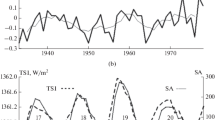Abstract
Research has been done on solar-terrestrial correlations on the basis of the organism model for the Earth, which suggests that the Earth affects the Sun by means of a natural energy and information flow and as a result of man-made factors. Changes in the Earth pattern affect regular processes in the solar system and cause new formations in solar activity. Solar-terrestrial correlations represent an energy and information flux and provide regulation mechanisms for the biosphere and the climatic engine on an evolutionary basis in strict agreement with the evolution of the solar system.
Similar content being viewed by others
Literature cited
A. N. Dmitriev, Vestn. Vyssh. Shkoly, No. 17, 38–44 (1989).
Lovelock L., Gaia, New Look at Life on Earth, Oxford Univ. Press, Oxford (1979).
O. White (ed.), Changes in Solar Energy Flux [Russian translation], Mir, Moscow (1980).
A. Brucen and S. Duran (eds.), Solar and Solar-Terrestrial Physics [Russian translation], Mir, Moscow (1980).
Richard A. Kerr, “No longer willful. Gaia becomes respectable,” Research News, 22 April (1988), pp. 383–395.
V. Ya. Shirokov, Seismicity and Seismic Forecasting in the Far East [in Russian], Petropavlovsk-Kamchatsk. DVNTs (1986), pp. 129–130.
N. I. Satkullin, Geomagnetism and High Layers in the Atmosphere [in Russian], VINITI, Moscow (1982).
A. N. Dmitriev, Man and Nature: Ways of Optimizing Relationships [in Russian], Severo-Osetinsk. Gos. Univ., Ordzhonikidze (1984), pp. 38–58.
V. I. Smirnov, A. I. Ginzburg, V. M. Grigor'ev, and G. F. Yakovlev, Ore-Deposit Textbook [in Russian], Nedra, Moscow (1986).
Radiation: Doses, Effects, and Risks, ICRP [Russian translation], Mir, Moscow (1988).
V. A. Loisha, Yu. K. Krakovetskii, and L. N. Popov, The Aurora: A Catalog for the Period from the Fourth to the Eighteenth Centuries [in Russian], IZMIRAN, Moscow (1989).
A. N. Dmitriev and V. K. Zhuravlev, The Tunguska Phenomenon of 1908: A Form of Solar-Terrestrial Relationship [in Russian], IGiG Sib. Otd. Akad. Nauk SSSR, Novosibirsk (1984).
A. N. Dmitriev, Current Topics in Siberian Meteoritics [in Russian], Nauka, Novosibirsk (1988), pp. 105–113.
N. P. Chirkov, Cosmic Material and the Earth [in Russian], Nauka, Novosibirsk (1986), pp. 215–217.
N. P. Chirkov and I. S. Samsonov, Geomag. Aeron.,24, No. 3, 300–303 (1984).
Author information
Authors and Affiliations
Additional information
Translated from Izvestiya Vysshikh Uchebnykh Zavedenii, Fizika, No. 3, pp. 105–110, March, 1992.
Rights and permissions
About this article
Cite this article
Dmitriev, A.N. The correcting role of unusual heliocentric atmospheric phenomena. Soviet Physics Journal 35, 290–294 (1992). https://doi.org/10.1007/BF00895777
Issue Date:
DOI: https://doi.org/10.1007/BF00895777



